So You’ve Decided to Make Your Own Hummingbird Food. What’s Next?
The hummingbird season is something that the birders, fascinated with the small flyers, wait anxiously. These tiny birds beat their wings an average of 70 times a second, and their heart rate can reach as high as 1,260 beats per minute. So that hummingbirds can fuel their incredibly high metabolisms, they must consume half their body weight in sugar daily.
Homemade hummingbird nectar mix is an easy and family-friendly DIY project requiring only two ingredients, white sugar, and water. However, there are some guidelines to follow to keep your visitors healthy and coming back for more year after year. Be ready and plan to put your hummingbird feeder up in plenty of time.
Ingredients Needed for your Hummingbird Nectar Recipe
Time: Less than five minutes, including clean up
Tools:
– Measuring cup
– Small bowl or saucepan
– Spoon
Ingredients:
– Water
– Refined white sugar. That’s right. Sugar water.
Use refined white sugar only. Do not use confectioners / powdered sugar, brown sugar, raw sugar, honey, organic sugar, or artificial sweeteners. While these sugars may be healthier alternatives for people, this is not the case for hummingbirds. Natural and raw sugars often have trace amounts of iron-rich molasses and iron that are toxic to hummingbirds. Plain white table sugar, when mixed with water, closely resembles the chemical composition of natural nectar.
Directions: RATIO: 1 part white sugar to 4 parts water.
Make nectar in small quantities and only make as much as is needed to refill feeders. If you make large quantities, store leftover, unused nectar in the refrigerator for up to 7-10 days to keep it fresh before use.
1. Start by combining ¼ cup sugar and 1 cup of water into your bowl or saucepan if boiling.
2. Heat the mixture, stirring with the spoon, until dissolving the sugar. It will usually take 1-2 minutes.
3. Allow the mixture to cool completely before filling your hummingbird feeders.
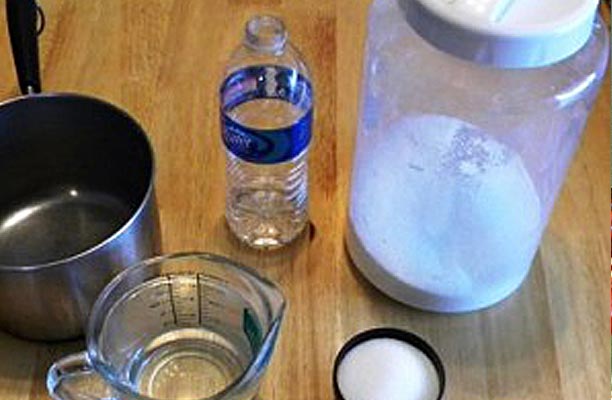
There is debate on whether to boil the water that we will address in the next paragraph. If you find the consumption of this amount is too quickly, increase your recipe the next time and store unused nectar in the fridge. Here is a handy conversion chart for larger quantities.
The Right Amount of Sugar
This ratio is essential. Too little sugar will not provide the necessary calories; too much sugar can harm the liver and kidneys of hummingbirds or lead to dehydration, calcium deficiencies, or bone malformation. A single Mosaic Birds Hummble Hummingbird Feeder uses only 1/3 of a cup, so a 1 cup recipe is suitable for a set of 3 feeders or three refills for a single feeder. If you create too much nectar, you can keep it in a bottle in the fridge for up to 14 days. Carefully check for spoilage before each use.
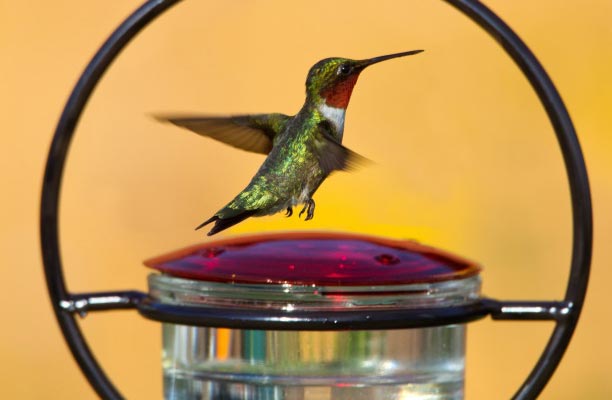
All of our Mosaic Birds Hummble Hummingbird Feeders are designed with a transparent base to easily observe the color of the nectar to judge if it needs to be replaced or refilled. Our glass base allows the hot nectar mix to be poured directly into the feeder without fear of disfigurement of plastics or chemical leaching.

Should You Boil the Water for Hummingbird Food?
Many birding enthusiasts believe it is not necessary to boil the water. Refined sugar easily dissolves in room temp water. While boiling will help slow the fermentation of the nectar initially, the nectar in hummingbird feeders is contaminated as soon as a bird sips it. Therefore, it is not necessary to boil the nectar after having dissolved the sugar. Stir vigorously so no sugar granules will clog the ports
If you prefer to boil, only do so for 1-2 minutes max as any longer will change the water-to-sugar ratio.
What About Store-Bought Hummingbird Food?
You can find commercial hummingbird nectars in ready-to-use, powder, or concentrate forms. Be sure to read the label to confirm if you can use the product as-is, or you must dilute it with water. Added time for measuring concentrates and water makes the DIY method even more time-efficient. Another factor to weigh is cost. Sugar is inexpensive and readily available. The recipe is super simple, and you can prepare it in less than 5 minutes, including clean-up. DIY hummingbird food can cost pennies per serving, a fraction of the cost of commercial varieties.
One more thing to check is if the product contains red dye. As mentioned earlier, there is no hard evidence that this is hazardous to hummers, but why risk it? There are also clear varieties without any dye marketed as healthier, but they can sometimes cost even more than the red versions. Again, it’s only sugar water. There is no need to break the bank to enjoy the charm of hummers outside a window.
How Long is the Shelf Life of Hummingbird Nectar?
To avoid bacteria growth that will repel your hummingbirds and potentially get them sick, you need to change the nectar frequently. The chart below shows how often to refresh the nectar. However, it’s also relevant to know how to determine if your nectar is bad.
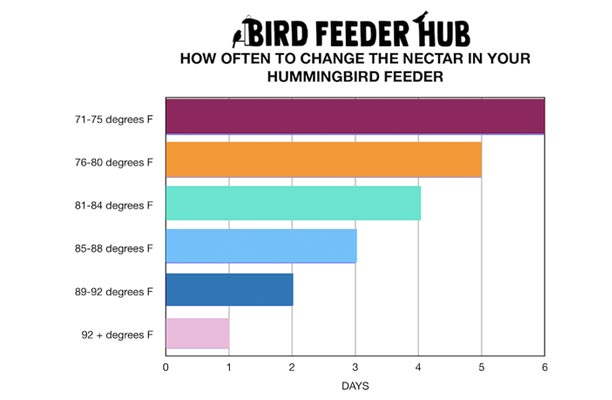
Should I Add Red Dye to Homemade Hummingbird Food Mixes?
The use of red dye in hummingbird nectar recipes is a controversial issue. There is no substantial evidence to prove Red Dye #40 is harmful to hummingbirds. On the other hand, there is not enough evidence to support that it is not harmful either. While red attracts hummers, there are different ways to include color in your garden better than adding dye to the nectar.
According to Bird Watchers Digest, most hummingbird feeders have red parts that attract the birds, such as red bases, feeding ports, or decorative accents that will attract birds without requiring or risking the addition of unessential dyes. If you want to use red to attract more hummingbirds to your feeders, consider planting red flowers nearby or adding a red gazing ball near the feeder to help catch the birds’ attention rather than exposing your visitors to unnecessary chemicals.
More Ways to Attract Hummingbirds to Your Yard or Garden
- Noticeable: Hummingbirds have keen eyesight, but they can overlook a feeder tucked under a deep roof or hidden in dense foliage. The feeder should catch some light, so colors and reflections are more easily seen and attract hummingbirds’ attention. If other red colors are nearby, hummingbirds will also notice the feeder more quickly.
- Safe: An unsafe hummingbird feeder can hurt birds, and feeders should always be hung high enough that cats or other predators will not be able to jump at feeding birds. The feeders should also be either very close to windows or far enough away that birds can avoid the glass rather than risk collisions. The Mosaic Birds Hummble Garden Stake expands to 44,” and you can add it to planters or flower pots for up-close viewing opportunities.
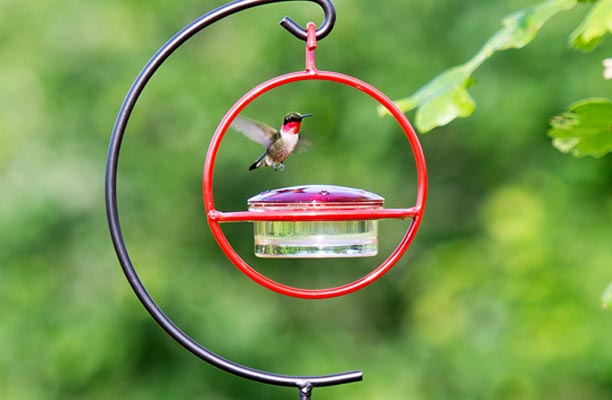
- Shaded: Nectar can spoil quickly on hot summer days, and if the feeder is in full sunlight all day long, it may not be suitable for hummingbirds for more than a day or two. Position the feeder in an area that gets afternoon shade to protect it from the hottest temperatures. Dappled shade under a tree is better than full sunlight and will still catch birds’ attention.
- Well-Spaced: Hummingbirds frequently hover while feeding, and if a feeder is nestled into dense foliage, the birds will not have enough space to maneuver comfortably around the feeder. These birds also prefer to be able to fly around the feeder in order to defend it from other birds.
- Private: Hummingbirds can be aggressive and territorial, and they will avoid feeding in areas where larger birds are active. Position hummingbird feeders away from other feeding stations, and distribute multiple hummingbird feeders throughout the yard so aggressive birds have their own spaces to defend and more birds can visit.
- Convenient: Ideally, feeders must be convenient for birders to clean and refill. This means positioning a feeder within easy reach, not so high that it is difficult to take down. Putting feeders near decks, patios or paths rather than deep in garden beds will also make them more accessible.
- Provide water for hummingbirds to use for bathing, preferably by moving water or misters.
You are Ready to Make Your Own Hummingbird Nectar Mix
Now that you know the simple recipe, decided whether to boil or not to boil, gathered your essential tools and ingredients, researched where the best place is to hang your feeder, have it hung and ready for visitors, and know your tiny feathered friends are due to arrive any day, you are ready to mix a batch of easy to make, healthy hummingbird food.
Hummingbirds are excellent at remembering exactly where they have found food before. They are equally as good at recognizing physical landmarks. Consequently, once a hummingbird finds your feeder, they will return again and again, providing you with hours of entertainment.
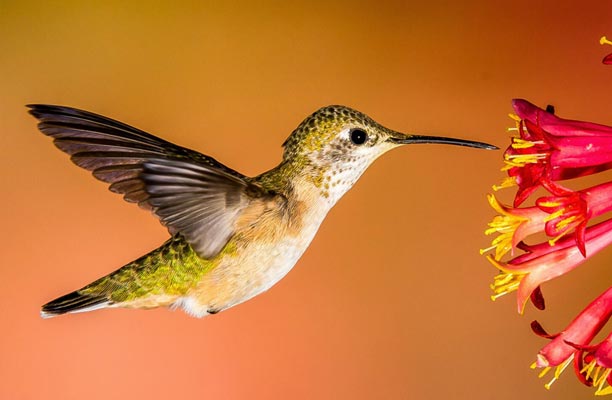

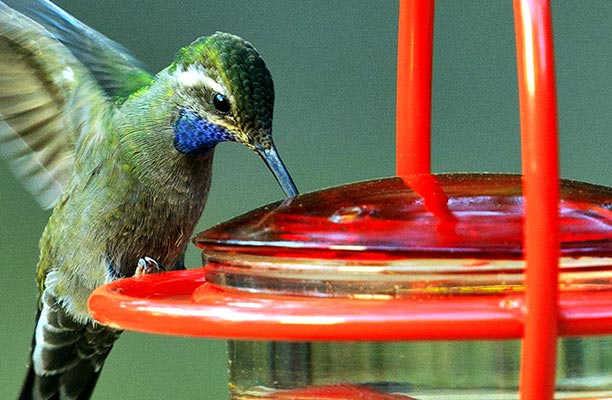
4 thoughts on “How to Make a Homemade Hummingbird Nectar Recipe”
Comments are closed.